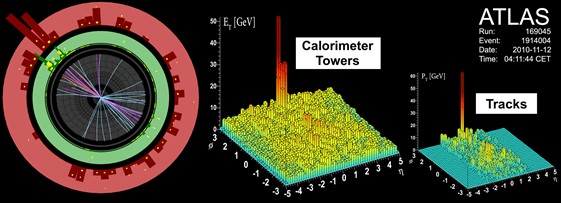Delivering new physics at impressive speed
The speed with which the heavy ion run at the LHC is delivering new physics is impressive not only for the insights it is bringing to the early Universe, but also for the clear demonstration it gives of the value of competition and complementarity between the experiments.
The creation, observation and understanding of the hot dense matter that would have existed in the early Universe, normally known as Quark Gluon Plasma (QGP), is complex science and one of the ion programme’s key goals. Many signals for QGP exist, and like pieces of a puzzle, we must assemble all of them to get the full picture. At the heart of the ALICE detector is the exotically named time projection chamber (TPC), a detector with an unparalleled ability to measure vast numbers of particle tracks. The TPC was key to ALICE’s first paper, which pointed to a large increase in the number of particles produced in the collisions compared to previous experiments at Brookhaven’s RHIC collider with lighter nuclei and lower energy. ALICE’s second paper confirms an earlier result from RHIC that the plasma seems to behave as a very low viscosity fluid. Taken together, these results have already ruled out some theories about how the primordial Universe behaved.
Add to that the result seen by ATLAS and CMS and we have the ingredients to start building up a clear picture of the primordial Universe. Both experiments measure jets of particles that emerge from collisions. Jets are formed as the basic constituents of nuclear matter, quarks and gluons, fly away from the collision point. In proton collisions, jets usually appear in pairs, emerging back to back. However, in heavy ion collisions the jets interact in the tumultuous conditions of the hot dense medium. This leads to a very characteristic signal, known as jet quenching, in which the energy of the jets can be severely degraded, signalling interactions with the medium. Jet quenching is a powerful tool for studying the behaviour of the plasma in detail.
LHC running for 2010 draws to a close this week. It’s been a great year, and these results provide suitable Christmas icing on the cake.
Rolf Heuer
Read more about this on the Press Release.


